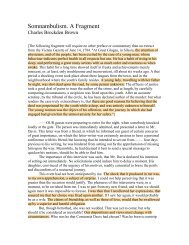Pt Two
Pt Two
Pt Two
Create successful ePaper yourself
Turn your PDF publications into a flip-book with our unique Google optimized e-Paper software.
UNIT NINE: Late Baroque and Rococo STUDY GUIDE<br />
G Antoine Watteau. Pierrot, called Gilles, c. 1718, oil on<br />
canvas<br />
(Pierrot) Gilles, an Italian actor/ commedia dell‟Arte/ a<br />
portrait of psychological insight/ an early death of<br />
tuberculosis<br />
1. “The more wistful side of Watteau can be seen in his undated Gilles, the<br />
sad Harlequin. The actor, in this case a comic lover, wears his costume, but<br />
does not perform. His pose is frontal, and his arms hang limply at his<br />
sides. His melancholy expression betrays his mood, and is at odds with the<br />
silk costume and pink ribbons on his shoes. Presently between roles, the<br />
actor is „all dressed up with nowhere to go.‟ The blue-gray sky echoes the<br />
figure‟s mood, as do the sunset-colored clouds. End of day, which is<br />
indicated by the sunset, corresponds to the sense that Gilles is at a loss<br />
about what to do next. His lonely isolation is accentuated by the four<br />
figures around him, who seem engaged in animated conversation” (Adams,<br />
Art Across Time 681).<br />
2. “Many of Watteau‟s paintings center on the commedia dell’arte. His<br />
treatment of this Italian theme is all the more remarkable because the<br />
commedia dell‟arte was officially banned in France from 1697 until 1716”<br />
(Janson 595). This work “was probably done as a sign for a café owned by a<br />
friend of the artist who retired from the stage after achieving fame in the<br />
racy role of the clown. The performance has ended, and the actor has<br />
stepped forward to face the audience. The other characters, all highly<br />
individualized, are probably likenesses of friends from the same circle. Yet<br />
the painting is more than a portrait or an advertisement. Watteau<br />
approaches his subject with incomparable human understanding and<br />
artistic genius. Pierrot is lifesize, so that he confronts us as a full human<br />
being, not simply as a stock character. In the process, Watteau transforms<br />
him into Everyman, with whom he evidently identified himself- a merging of<br />
identity basic to the commedia dell‟arte… Like the rest of the actors, except<br />
the doctor on the donkey who looks mischievously at us, he seems lost in<br />
his own thoughts” (595).<br />
4. “The large scale of the picture is surprising, and the onlooker is drawn to<br />
the curiously static centrally placed figure, dressed in theatrical costume,<br />
his arms and hands hanging symmetrically in front of him. His facial<br />
expression seems to combine both mirth and sadness, perhaps suggesting<br />
the transitory nature of pleasure. Shortly after Watteau made this painting<br />
he died of tuberculosis as did the patron and model of the work” (Bolton 74).<br />
5. “Tragically, Watteau died from tuberculosis<br />
when still in his thirties. During his final<br />
illness, while staying with the art dealer Edme-<br />
Francois Gersaint, he painted a signboard for<br />
Gersaint‟s shop. The dealer later wrote,<br />
implausibly, that Watteau had completed the<br />
painting in about a week, working only in the<br />
mornings because of his failing health” (810).<br />
6. “The curious spatial relationship between the<br />
central figure and the other actors can be<br />
explained by supposing that Gilles is standing<br />
on a raised, narrow stage made to look like a<br />
piece of ground. Behind this platform, the other<br />
actors are coming up behind him with the<br />
donkey, and the background is a painted backcloth, strictly speaking a<br />
picture within a picture. This witty interplay links the painting to Gersaint’s<br />
Shop Sign, while the construction of the stage is reminiscent of that in<br />
French Players” (Borsch-Supan 62). “A comparison with Hyacinthe<br />
Rignaud‟s Louis XIV in Armor of 1701 makes this work… seem almost like a<br />
calculated insult to royalty. The comedy of the role of Pierrot turns to<br />
dignity, and the symmetry of the large format engenders a sense of majesty<br />
based on the nature of humanity” (57).<br />
24<br />
H Francois Boucher. Cupid a Captive,<br />
1754, oil on canvas<br />
Francois Boucher/ Rococo sense of sensual<br />
playfulness/ pastel colors/ artificial<br />
treatment of nature/ Madame de<br />
Pompadour<br />
1. “The artist most closely<br />
associated today with<br />
Parisian Rococo painting is<br />
Francois Boucher (1703-<br />
1770), who never met<br />
Watteau. In 1721,<br />
Boucher, the son of a minor<br />
painter, entered the<br />
workshop of an engraver to<br />
support himself as he<br />
attempted to win favor at<br />
the Academy. The young<br />
man‟s skill drew the<br />
attention of a devotee of<br />
Watteau, who hired<br />
Boucher to reproduce<br />
Watteau‟s paintings in his<br />
collection, an event that<br />
firmly established the<br />
direction of Boucher‟s<br />
career” (Stokstad, Art<br />
History 812).<br />
2. “After studying at the French Academy in Rome from<br />
1727 to 1731, Boucher settled in Paris and became an<br />
academician. Soon his life and career were intimately<br />
bound up with two women: The first was his artistically<br />
talented wife, Marie-Jeanne Buseau, who was a<br />
frequent model as well as a studio assistant to her<br />
husband. The other was Louis XV‟s mistress, Madame<br />
de Pompadour, who became his major patron and<br />
supporter. Pompadour was an amateur artist herself<br />
and took lessons from Boucher in printmaking. After<br />
Boucher received his first royal commission in 1735, he<br />
worked almost continuously to decorate the royal<br />
residences at Versailles and Fontainebleau. In 1755,<br />
he was made chief inspector at the Gobelins Tapestry<br />
Manufactory, and he provided designs to it and to the<br />
Sevres porcelain and Beauvais tapestry manufactories,<br />
all of which produced furnishings for the king” (812).<br />
3. “As a promoter of moral painting, the French critic<br />
Denis Diderot despised Boucher. In his Salon reviews<br />
of 1765 he wrote: „I don‟t know what to say about this<br />
man. Degradation of taste, color, composition,<br />
character, expression, and drawing have kept pace with<br />
moral depravity‟” (Minor 195). “Many critics have<br />
dismissed or denounced Boucher for his „frivolous‟<br />
subject matter… but it takes a narrow and puritanical<br />
nature to miss the importance of these paintings” (195).<br />
“Boucher‟s brushwork is as abandoned as the mood of<br />
his paintings. Not that he was messy or thoughtless in<br />
his technique; he simply understood that painting can<br />
bewitch the spectator with its sheer audacity, its<br />
exuberant love of the act of fashioning paints into<br />
luxurious forms” (195). “Neither the King nor his<br />
mistress were lazy, but they understood the erotic and<br />
pleasurable charge of indolence” (195).

















